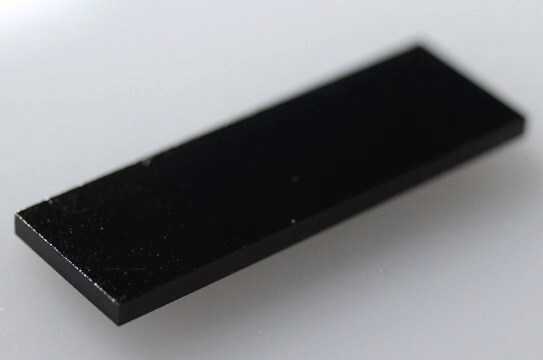추천 제품
양식
solid
Quality Level
구성
~ 4 wt.% loading of catalyst
반응 적합성
reagent type: catalyst
reaction type: Cross Couplings
SMILES string
Cl[Pd]Cl
InChI
1S/2ClH.Pd/h2*1H;/q;;+2/p-2
InChI key
PIBWKRNGBLPSSY-UHFFFAOYSA-L
일반 설명
Palladium(II) chloride (PdCl2) reacts with unsubstituted or alkyl-substituted cyclic ketones in the CO atmosphere to afford acyclic diesters and acyclic chloro-substituted monoesters. PdCl2 reacts with N,N-dimethylallylamine in methanol to afford di-μ-chloro-bis(2-methoxy-3-N,N-dimethylaminopropyl)dipalladium(II). Palladium dichloride, acetate and acetylacetonate in the [bmim][BF4] or [bmim][PF6] (where[bmim]+ = 1-butyl-3-methylimidazolium cation) ionic liquids have been employed for the hydrodimerization of butadiene to form octa-2,7-dien-1-ol.
애플리케이션
Application Guide for Palladium Catalyzed Cross-Coupling Reactions
Used in the synthesis of semiconducting metal-containing polymers in which the polypyrrole backbone has a conformational energy minimum and is nearly planar.
Used in the synthesis of semiconducting metal-containing polymers in which the polypyrrole backbone has a conformational energy minimum and is nearly planar.
Palladium(II) chloride (PdCl2) was used in the following studies:
ChemBeads are chemical coated glass beads. ChemBeads offer improved flowability and chemical uniformity perfect for automated solid dispensing and high-throughput experimentation. The method of creating ChemBeads uses no other chemicals or surfactants allowing the user to accurately dispense sub-milligram amounts of chemical.
Learn more about ChemBeads products
For larger scale uses, product also available in powdered form (205885) & (520659)
- As catalyst for the carbonylation of organic tellurides by reaction with carbon monoxide.
- As a catalyst along with Cu(II) for the deamination of phenethylamines to phenyl substituted pyrroles.
- Together with PEG 300, promoted efficient Suzuki-coupling of aryl chlorides with aryl boronic acids.
ChemBeads are chemical coated glass beads. ChemBeads offer improved flowability and chemical uniformity perfect for automated solid dispensing and high-throughput experimentation. The method of creating ChemBeads uses no other chemicals or surfactants allowing the user to accurately dispense sub-milligram amounts of chemical.
Learn more about ChemBeads products
For larger scale uses, product also available in powdered form (205885) & (520659)
기타 정보
High-Throughput Reaction Screening with Nanomoles of Solid Reagents Coated on Glass Beads
Versatile Methods to Dispense Sub-Milligram Quantities of Solids using Chemical Coated Beads for High-Throughput Experimentation
ChemBead Enabled High-Throughput Cross-Electrophile Coupling Reveals a New Complementary Ligand
Versatile Methods to Dispense Sub-Milligram Quantities of Solids using Chemical Coated Beads for High-Throughput Experimentation
ChemBead Enabled High-Throughput Cross-Electrophile Coupling Reveals a New Complementary Ligand
신호어
Danger
유해 및 위험 성명서
Hazard Classifications
Aquatic Acute 1 - Aquatic Chronic 1 - Carc. 1B Inhalation - Eye Dam. 1 - Met. Corr. 1 - Skin Sens. 1
Storage Class Code
6.1C - Combustible acute toxic Cat.3 / toxic compounds or compounds which causing chronic effects
WGK
WGK 3
가장 최신 버전 중 하나를 선택하세요:
Yoshikazu Mori et al.
The Journal of organic chemistry, 68(4), 1571-1574 (2003-02-15)
Treatment of thiol esters 1 with zinc reagent 2 in the presence of a small amount (<ca. 1 mol %) of nonpyrophoric Pd(OH)(2)/C (Pearlman's catalyst) provided functionalized asymmetrical ketones 3 in high yields. The use of Pd(OH)(2)/C was further applied
Xiaobing Wan et al.
Journal of the American Chemical Society, 128(37), 12046-12047 (2006-09-14)
A unique method was discovered to construct polysubstituted pyrroles via an unprecedented multiple deprotonations/deaminations process from commercially available phenethylamines. During this transformation, twelve bonds were broken and five new bonds were constructed.
Chun Liu et al.
Organic & biomolecular chemistry, 9(4), 1054-1060 (2010-12-15)
A simple and efficient protocol has been developed for the PdCl(2)-catalyzed ligand-free and aerobic Suzuki reaction of aryl bromides or nitrogen-based heteroaryl bromides with arylboronic acids in good to excellent yields in aqueous ethanol. A systematic investigation on the effect
Feng-Quan Yuan et al.
Chemical communications (Cambridge, England), 47(18), 5289-5291 (2011-04-01)
We present a PdCl(2)-catalyzed protocol for highly efficient allylation and benzylation of a rich variety of N-, O-, and S-containing heteroarenes under base/acid, additive, and ligand-free conditions. The method represents the very few examples for simple, universally applicable, clean, and
[(RCN)2PdCl2]-catalyzed E/Z isomerization of alkenes: a non-hydride binuclear addition-elimination pathway.
Emily H P Tan et al.
Angewandte Chemie (International ed. in English), 50(41), 9602-9606 (2011-09-23)
문서
ChemBeads, catalyst-coated glass beads, dispense solid chemical reagents for nanomole-scale high-throughput reaction screening.
자사의 과학자팀은 생명 과학, 재료 과학, 화학 합성, 크로마토그래피, 분석 및 기타 많은 영역을 포함한 모든 과학 분야에 경험이 있습니다..
고객지원팀으로 연락바랍니다.

![[1,1′-Bis(diphenylphosphino)ferrocene]dichloropalladium(II) ChemBeads](/deepweb/assets/sigmaaldrich/product/structures/276/683/e8a8b162-1e17-467b-8eb6-f4180a60a1b9/640/e8a8b162-1e17-467b-8eb6-f4180a60a1b9.png)









